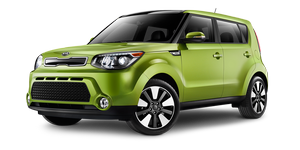Kia Soul 2014-2019 PS Owner's Manual

Owners Manual for Second generation (PS) Kia Soul, Model years 2014–2019. The Big Apple, perhaps America's most iconic metropolis, has played host to the global unveiling of Kia Motors' most iconic people mover, the all-new Soul urban utility vehicle, at the 2013 New York International Auto Show. The signature Soul design is instantly recognizable yet thoroughly fresh, with more than a passing nod to the hot Track'ster concept that was unveiled in 2012.
- Introduction
- How to use this manual
- Fuel requirements
- Vehicle handling instructions
- Vehicle break-in process
- Vehicle data collection and event data recorders
- Your vehicle at a glance
- Safety features of your vehicle
- Features of your vehicle
- Keys
- SMART KEY
- Door locks
- Tailgate
- Windows
- Hood
- Fuel filler lid
- Panoramic sunroof
- Steering wheel
- Mirrors
- Instrument cluster
- LCD display (if equipped)
- Trip computer
- Warning and indicator lights
- Rear camera display (if equipped)
- Lighting
- Wipers & Washers
- Interior light
- Defroster
- Climate control system
- Automatic climate control system
- Windshield defrosting and defogging
- Clean air(if equipped)
- Storage compartment
- Interior features
- Exterior features
- Audio system
- Using the USB device
- Using iPod┬о device
- Voice Recognition
- System controllers and functions
- SETUP
- SOUND SETTINGS
- CLOCK SETTINGS
- SYSTEM SETTINGS
- BASIC METHOD OF USE
- MENU : USB
- Phone(if equipped)
- Using Bluetooth┬о Wireless Technology(if equipped)
- Voice recognition
- Driving your vehicle
- Before driving
- Key positions (if equipped)
- Engine start/stop button
- Transaxle
- Automatic transaxle (if equipped)
- Brake system
- Cruise control system
- Active ECO system
- ISG (Idel Stop and Go) system
- Economical operation
- Special driving conditions
- Winter driving
- Vehicle load limit
- Vehicle weight glossary
- What to do in an emergency
- Road warning
- Emergency while driving
- If the engine will not start
- Emergency starting
- Engine overheat
- Tire pressure monitoring system
- Flat tire
- If you have a flat tire (tire mobility kit, if equipped)
- Towing
- Maintenance
- Engine compartment
- Maintenance service
- Scheduled maintenance service
- Normal maintenance schedule
- Maintenance under severe usage conditions
- Explanation of scheduled maintenance items
- Engine oil
- Engine coolant
- Brake fluid
- Washer fluid
- Parking brake
- Air cleaner
- Climate control air filter
- Wiper blades
- Battery
- Tire and wheels
- Fuses
- Light bulbs
- Appearance care
- Exterior care
- Emission control system
- Specifications, Consumer information and Reporting safety defects
- Dimensions
- Engine
- Bulb wattage
- Tires and wheels
- Capacity/weight
- Recommended lubricants and capacities
- Vehicle identification number (VIN)
- Vehicle certification label
- Tire specification and pressure label
- Engine number
- Refrigerant label
- Consumer assistance
- Electrical equipment
- Reporting safety defects
- Online factory authorized manuals
 Introduction
Introduction
...
See also:
Rearview camera
...
Components
1. Rear bumper cover
2. Rear bumper side bracket
...
Transmitter precautions
✽ NOTICE
The transmitter will not work if any of following occur:
The ignition key is in the ignition switch.
You exceed the operating distance limit (about 30 feet [10 m]).
The batter ...
